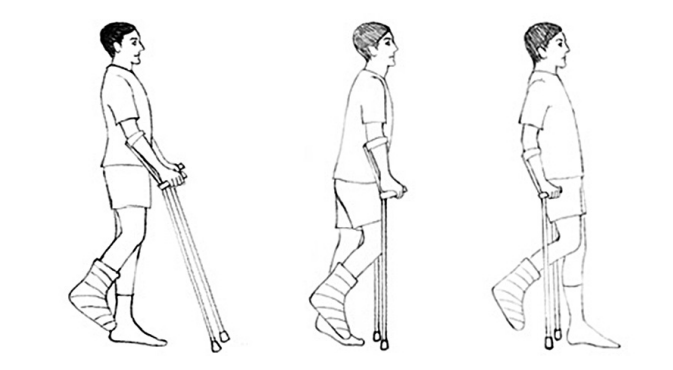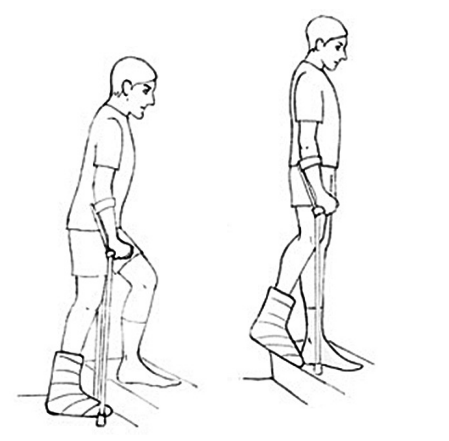Advice and safety
You will either have been given elbow crutches (metal) or underarm crutches (wood). Here are some instructions on how to use your crutches.
To stand:
- You should have them near to hold after pushing off from the chair or have both your crutches in one hand and push up with the other.
- You should push up from a stable chair, bring hips forward to edge of chair and have crutches nearby ready to use.
- Once standing, transfer one crutch into the other hand.
- Put the crutches in front of you and get your balance.
To sit:
- Make sure that your chair is immediately behind you, by feeling for the edge of the chair against the back of your knees.
- You should put both your crutches in one hand.
- Hold the chair arm with your other hand.
- Place your injured leg further forward than your other leg, sit down gently.
To walk:
If you are allowed to put weight on your injured leg:
- Put both your crutches forward.
- Put your injured leg one step forward in between your crutches.
- Take your weight through your hands and step forward with your good leg.
- Put both your crutches forward.
If you are not allowed to put weight on your injured leg:

- Put both your crutches forward together.
- Make sure you keep your injured leg off the floor and in front of you, with knee flexed.
- Take your weight onto your hands and arms.
- Bring your good leg forward, just past the crutches to help keep your balance.
- You must not lean on the crutches through your armpit as this may cause nerve damage.
Stairs
If you feel unsafe or unsteady, go up and down on your bottom. If it is essential to use the stairs and if you have not been advised otherwise, try to have someone with you until you feel safe.
- Hold onto at least one handrail if possible.
- Hold the spare crutch together with the handle of the remaining crutch.
- The crutch(es) goes on the same step as the affected leg
Going up
The unaffected leg goes first, being followed by the affected leg onto the same step, with the
crutches. The procedure is repeated.

Going down
The affected leg goes first with the crutches, being followed by the unaffected leg onto the same step. The procedure is repeated, if partially weight bearing. If non weight baring – the good leg goes first followed by the crutches.

Exercises
- To prevent foot swelling when you are not up and about, sit with your leg elevated so that your foot is higher than your hip.
- Support your knee to prevent a strain.
- To improve circulation, curl and stretch your toes, circle your ankle if you are able to and clench the thigh muscle for 5 minutes every hour.
- If your leg is not in a plaster cast, you may be given more active exercises to promote the healing of your injury. Do these exercises as instructed.
General safety
- Wear flat supportive shoes with a full shoe.
- Use a chair with a high seat and arms to help you sit and stand up with ease.
- Remove obstacles in your home such as loose rugs.
- Avoid wet floors.
- Ensure adequate lighting.
- Beware of door hazards including uneven surfaces, wet leaves and ice.
- Regularly inspect the crutches for wear, eg bent or damaged tubes or loose rivets, ensure that pin adjustment holes used to alter crutch length are not worn.
- Check that the rubber ends are not worn or clogged with dirt or stones.
- If you have a problem with the crutches, contact the Minor Injuries Unit at Victoria Central Health Centre.
When no longer needed please return the crutches to the Minor Injury Unit at Victoria Central Health Centre.
Slow small steps are safe. If you go too fast, you may fall!
Please contact your GP or NHS111 for any queries or concerns.
Download the PDF: